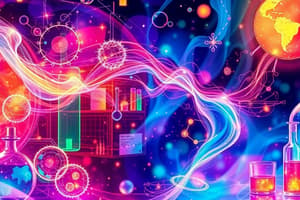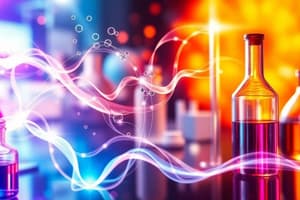Podcast
Questions and Answers
What is the purpose of chromatography?
What is the purpose of chromatography?
Chromatography is a laboratory technique used to separate, identify, and analyze the components of a mixture.
What are the two phases involved in chromatography?
What are the two phases involved in chromatography?
- Stationary phase and Mobile phase (correct)
- Solid phase and Liquid phase
- Gas phase and Liquid phase
- None of the above
Which type of chromatography uses high pressure to achieve rapid and precise separation?
Which type of chromatography uses high pressure to achieve rapid and precise separation?
- Thin-Layer Chromatography
- High-Performance Liquid Chromatography (HPLC) (correct)
- Liquid Chromatography
- Gas Chromatography
What type of chromatography separates molecules based on their size?
What type of chromatography separates molecules based on their size?
What are the major applications of liquid chromatography?
What are the major applications of liquid chromatography?
What is the stationary phase in gas chromatography?
What is the stationary phase in gas chromatography?
What is the principle behind thin-layer chromatography?
What is the principle behind thin-layer chromatography?
What are the applications of affinity chromatography?
What are the applications of affinity chromatography?
What is the purpose of column chromatography?
What is the purpose of column chromatography?
What is the general concept of extraction?
What is the general concept of extraction?
What is the principle behind liquid-liquid extraction?
What is the principle behind liquid-liquid extraction?
What is the principle behind supercritical fluid extraction?
What is the principle behind supercritical fluid extraction?
What is the principle behind Soxhlet extraction?
What is the principle behind Soxhlet extraction?
What is the principle behind ultrasonic-assisted extraction?
What is the principle behind ultrasonic-assisted extraction?
What is the primary application of chromatography in pharmaceuticals?
What is the primary application of chromatography in pharmaceuticals?
What is the primary application of extraction in pharmaceuticals?
What is the primary application of extraction in pharmaceuticals?
How is chromatography integrated with extraction in the pharmaceutical industry?
How is chromatography integrated with extraction in the pharmaceutical industry?
What are the key benefits of using chromatographic and extraction techniques in the pharmaceutical industry?
What are the key benefits of using chromatographic and extraction techniques in the pharmaceutical industry?
What is the major advantage of using High-Performance Liquid Chromatography (HPLC) in pharmaceuticals?
What is the major advantage of using High-Performance Liquid Chromatography (HPLC) in pharmaceuticals?
What is the primary application of gas chromatography (GC) in pharmaceuticals?
What is the primary application of gas chromatography (GC) in pharmaceuticals?
What is the primary application of thin-layer chromatography (TLC) in pharmaceuticals?
What is the primary application of thin-layer chromatography (TLC) in pharmaceuticals?
What is the primary application of affinity chromatography in pharmaceuticals?
What is the primary application of affinity chromatography in pharmaceuticals?
What is the primary application of ion-exchange chromatography in pharmaceuticals?
What is the primary application of ion-exchange chromatography in pharmaceuticals?
What is the principle behind liquid-liquid extraction (LLE) in pharmaceuticals?
What is the principle behind liquid-liquid extraction (LLE) in pharmaceuticals?
What is the principle behind supercritical fluid extraction (SFE) in pharmaceuticals?
What is the principle behind supercritical fluid extraction (SFE) in pharmaceuticals?
What is the principle behind Soxhlet extraction in pharmaceuticals?
What is the principle behind Soxhlet extraction in pharmaceuticals?
What is the principle behind ultrasonic-assisted extraction (UAE) in pharmaceuticals?
What is the principle behind ultrasonic-assisted extraction (UAE) in pharmaceuticals?
What are the major applications of chromatography and extraction in drug discovery?
What are the major applications of chromatography and extraction in drug discovery?
What are the major applications of chromatography and extraction in formulation development?
What are the major applications of chromatography and extraction in formulation development?
What are the major applications of chromatography and extraction in quality assurance?
What are the major applications of chromatography and extraction in quality assurance?
What is the significance of using chromatography and extraction techniques in the pharmaceutical industry?
What is the significance of using chromatography and extraction techniques in the pharmaceutical industry?
Which techniques are used to isolate penicillin in a pharmaceutical production process?
Which techniques are used to isolate penicillin in a pharmaceutical production process?
Flashcards
Chromatography
Chromatography
A laboratory technique used to separate, identify, and analyze the components of a mixture based on their differential interaction with a stationary phase and a mobile phase.
Stationary phase
Stationary phase
A solid or liquid phase fixed in place, with which components of a mixture interact differently.
Mobile phase
Mobile phase
A liquid or gas that moves through the stationary phase, carrying the components of a mixture.
Separation mechanism
Separation mechanism
Signup and view all the flashcards
Liquid chromatography (LC)
Liquid chromatography (LC)
Signup and view all the flashcards
High-performance liquid chromatography (HPLC)
High-performance liquid chromatography (HPLC)
Signup and view all the flashcards
Size-exclusion chromatography
Size-exclusion chromatography
Signup and view all the flashcards
Ion-exchange chromatography
Ion-exchange chromatography
Signup and view all the flashcards
Gas chromatography (GC)
Gas chromatography (GC)
Signup and view all the flashcards
Thin-layer chromatography (TLC)
Thin-layer chromatography (TLC)
Signup and view all the flashcards
Paper chromatography
Paper chromatography
Signup and view all the flashcards
Affinity chromatography
Affinity chromatography
Signup and view all the flashcards
Column chromatography
Column chromatography
Signup and view all the flashcards
Extraction
Extraction
Signup and view all the flashcards
Liquid-liquid extraction (LLE)
Liquid-liquid extraction (LLE)
Signup and view all the flashcards
Solid-liquid extraction (SLE)
Solid-liquid extraction (SLE)
Signup and view all the flashcards
Supercritical fluid extraction (SFE)
Supercritical fluid extraction (SFE)
Signup and view all the flashcards
Soxhlet extraction
Soxhlet extraction
Signup and view all the flashcards
Ultrasonic-assisted extraction (UAE)
Ultrasonic-assisted extraction (UAE)
Signup and view all the flashcards
Drug purity testing
Drug purity testing
Signup and view all the flashcards
Active ingredient detection
Active ingredient detection
Signup and view all the flashcards
Dissolution testing
Dissolution testing
Signup and view all the flashcards
Residual solvent analysis
Residual solvent analysis
Signup and view all the flashcards
Monoclonal antibody purification
Monoclonal antibody purification
Signup and view all the flashcards
Vaccine development
Vaccine development
Signup and view all the flashcards
Alkaloid extraction
Alkaloid extraction
Signup and view all the flashcards
Essential oil extraction
Essential oil extraction
Signup and view all the flashcards
Lipid extraction
Lipid extraction
Signup and view all the flashcards
Polyphenol extraction
Polyphenol extraction
Signup and view all the flashcards
Herbal drug development
Herbal drug development
Signup and view all the flashcards
Formulation development
Formulation development
Signup and view all the flashcards
API consistency
API consistency
Signup and view all the flashcards
Impurity analysis
Impurity analysis
Signup and view all the flashcards
Study Notes
Chromatography
- Chromatography is a lab technique used to separate, identify, and analyze the components of a mixture.
- Separation is based on how different components interact with a stationary phase (solid or liquid) and a mobile phase (liquid or gas).
- Components that more strongly interact with the stationary phase move more slowly while those that are more soluble in the mobile phase move faster.
Types of Chromatography
- Liquid Chromatography (LC):
- Stationary phase: Solid or liquid
- Mobile phase: Liquid
- Applications: Analysis of pharmaceuticals, biomolecules, environmental samples
- Subtypes:
- High-Performance Liquid Chromatography (HPLC): High-pressure system for rapid, precise separation
- Size-Exclusion Chromatography: Separates molecules based on size
- Ion-Exchange Chromatography: Separates ions and polar molecules based on charge
- Gas Chromatography (GC):
- Stationary phase: Liquid or solid coating inside a column
- Mobile phase: Inert gas (e.g., helium, nitrogen)
- Applications: Volatile and thermally stable compounds (e.g., hydrocarbons, fragrances)
Other Chromatography Techniques
- Thin-Layer Chromatography (TLC):
- Stationary phase: Silica gel or alumina on a flat surface
- Mobile phase: Solvent or solvent mixture
- Applications: Quick, qualitative analysis of mixtures
- Paper Chromatography:
- Stationary phase: Filter paper (cellulose)
- Mobile phase: Solvent (aqueous or organic)
- Applications: Separation of pigments or small polar molecules
- Affinity Chromatography:
- Stationary phase: Specific ligands that bind to target molecules
- Mobile phase: Buffer or solution
- Applications: Purification of proteins, enzymes, and antibodies
- Column Chromatography:
- Stationary phase: Packed column (solid adsorbent)
- Mobile phase: Solvent or mixture
- Applications: General purification of compounds
Extraction
- Extraction is a process used for separating a desired substance from a mixture using a solvent.
- It exploits differences in solubility (or chemical affinity) between components.
- Liquid-Liquid Extraction (LLE):
- Principle: Partitioning of a solute between two immiscible liquids (e.g., oil and water).
- Solid-Liquid Extraction (SLE):
- Principle: Dissolution of a solute from a solid matrix into a solvent.
- Supercritical Fluid Extraction (SFE):
- Principle: Using supercritical CO2 as a solvent to extract compounds.
Applications
- Pharmaceuticals:
- Chromatography: Purification of drugs, active ingredients, isolating plant-derived bioactive compounds.
- Extraction: Isolating plant-derived bioactive compounds, recovery of antibiotics from fermentation processes.
- Food Industry:
- Chromatography: Identifying food additives, preservatives, and contaminants.
- Extraction: Obtaining flavors, colors, and nutrients.
- Environmental Science:
- Chromatography: Detecting pollutants in air, water, and soil; Isolating toxic substances for analysis.
- Biotechnology:
- Chromatography: Protein purification
- Extraction: Recovery of biomolecules from fermentation processes
Studying That Suits You
Use AI to generate personalized quizzes and flashcards to suit your learning preferences.




